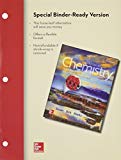
Concept explainers
(a)
Interpretation:
The mole ratio of each product to the reactant
(a)
Explanation of Solution
The balanced equation of the given reaction is:
It is apparent from the equation that
The required mole ratios for water to ammonium nitrate are:
(b)
Interpretation:
The number of moles of each product formed when
(b)
Explanation of Solution
The balanced equation of the given reaction is:
It is apparent from the equation that
Similarly, for oxygen,
Similarly, for water,
(c)
Interpretation:
The number of moles of each product formed when
(c)
Explanation of Solution
The balanced equation of the given reaction is:
It is apparent from the equation that
Similarly, for oxygen,
Similarly, for water,
Want to see more full solutions like this?
Chapter 6 Solutions
Combo: Loose Leaf for Introduction to Chemistry with Connect Access Card Chemistry with LearnSmart 1 Semester Access Card
- 4.12 In petroleum refining, hydrocarbons are often manipulated by reacting them with H2(g). If hexene, C6H12, is reacted with hydrogen to form hexane, C6H14, how many moles of hydrogen are needed to react with 453 moles of hexene?arrow_forward4.8 In an experiment carried out at very low pressure, 13x1015 molecules of H2 are reacted with acetylene, C2H2, to form ethane, C2H6, on the surface of a catalyst. Write a balanced chemical equation for this reaction. How many molecules of acetylene are consumed?arrow_forward4.69 The pictures below show a molecular-scale view of a chemical reaction between H2 and CO to produce methanol, CH3OH. The box on the left represents the reactants at the instant of mixing, and the box on the right shows what is left once the reaction has gone to completion. Was there a limiting reactant in this reaction? If so, what was it? Write a balanced chemical equation for this reaction. As usual, your equation should use the smallest possible whole number coefficients for all substances.arrow_forward
- 4.44 Industrial production of hydrogen gas uses the reaction shown below. If 1.00 metric ton of propane reacting with excess water yields 270 kg of H2, what is the percentage yield? C3H8(g)+3H2O(l)3CO(g)+7H2(g)arrow_forwardPropane, C3H8, is the fuel of choice in a gas barbecue. When burning, the balanced equation is C3H8+5O23CO2+4H2O a What is the limiting reactant in cooking with a gas grill? b If the grill will not light and you know that you have an ample flow of propane to the burner, what is the limiting reactant? c When using a gas grill you can sometimes turn the gas up to the point at which the flame becomes yellow and smokey. In terms of the chemical reaction, what is happening?arrow_forward4.24 Ammonia gas can be prepared by the reaction CaO(s)+2NH4Cl(s)2NH3(g)+H2O(g)+CaCl2(s) If 112 g of CaO reacts with 224 g of NH4Cl, how many moles of reactants and products are there when the reaction is complete?arrow_forward
- 4-93 Ammonia is prepared industrially by the reaction of nitrogen and hydrogen according to the following equation: If 29.7 kg of N2 is added to 3.31 kg of H2, (a) Which reactant is the limiting reagent? (b) How many grams of the other reactant are left over? (c) How many grams of NH3 are formed if the reaction goes to completion?arrow_forwardThe pictures below show a molecular-scale view of a chemical reaction between H2 and CO to produce methanol, CH3OH The box on the left represents the reactants at the instant of mixing, and the box on the right shows what is left once the reaction has gone to completion. D Was there a limiting reactant in this reaction? If so, what was it? Write a balanced chemical equation for this reaction. As usual, your equation should use the smallest possible whole number coefficients for all substances.arrow_forwardNitrogen monoxide is oxidized in air to give brown nitrogen dioxide. Starting with 2.2 mol NO, calculate how many moles and how many grams of O2 are required for complete reaction. Calculate what mass of NO2, in grams, is produced.arrow_forward
- Urea is used as a fertilizer because it can react with water to release ammonia, which provides nitrogen to plants. (NH2)2CO(s) + H2O() 2 NH3(aq) + CO2(g) (a) When 300. g urea and 100. g water are combined, calculate the mass of ammonia and the mass of carbon dioxide that form. (b) Calculate the mass of the excess reactant that remains after reaction.arrow_forwardWhen potassium chlorate is subjected to high temperatures, it decomposes into potassium chloride and oxygen. (a) Write a balanced equation for the decomposition. (b) In this decomposition, the actual yield is 83.2%. If 198.5 g of oxygen are produced, how much potassium chlorate decomposed?arrow_forward4.110 Write the balanced chemical equation lot the combustion of ethane, C2H6, and answer these questions. (a) How many molecules of oxygen would combine with 14 molecules of ethane in this reaction? (b) If 13.0 mol of oxygen is consumed in a reaction, how many moles of water are produced? (e) How many grams of ethane are burned if 4.201022 molecules of CO2 are produced?arrow_forward
 Chemistry for Engineering StudentsChemistryISBN:9781337398909Author:Lawrence S. Brown, Tom HolmePublisher:Cengage Learning
Chemistry for Engineering StudentsChemistryISBN:9781337398909Author:Lawrence S. Brown, Tom HolmePublisher:Cengage Learning Chemistry & Chemical ReactivityChemistryISBN:9781133949640Author:John C. Kotz, Paul M. Treichel, John Townsend, David TreichelPublisher:Cengage Learning
Chemistry & Chemical ReactivityChemistryISBN:9781133949640Author:John C. Kotz, Paul M. Treichel, John Townsend, David TreichelPublisher:Cengage Learning Chemistry: The Molecular ScienceChemistryISBN:9781285199047Author:John W. Moore, Conrad L. StanitskiPublisher:Cengage Learning
Chemistry: The Molecular ScienceChemistryISBN:9781285199047Author:John W. Moore, Conrad L. StanitskiPublisher:Cengage Learning Chemistry for Engineering StudentsChemistryISBN:9781285199023Author:Lawrence S. Brown, Tom HolmePublisher:Cengage Learning
Chemistry for Engineering StudentsChemistryISBN:9781285199023Author:Lawrence S. Brown, Tom HolmePublisher:Cengage Learning General Chemistry - Standalone book (MindTap Cour...ChemistryISBN:9781305580343Author:Steven D. Gammon, Ebbing, Darrell Ebbing, Steven D., Darrell; Gammon, Darrell Ebbing; Steven D. Gammon, Darrell D.; Gammon, Ebbing; Steven D. Gammon; DarrellPublisher:Cengage Learning
General Chemistry - Standalone book (MindTap Cour...ChemistryISBN:9781305580343Author:Steven D. Gammon, Ebbing, Darrell Ebbing, Steven D., Darrell; Gammon, Darrell Ebbing; Steven D. Gammon, Darrell D.; Gammon, Ebbing; Steven D. Gammon; DarrellPublisher:Cengage Learning Chemistry: Principles and ReactionsChemistryISBN:9781305079373Author:William L. Masterton, Cecile N. HurleyPublisher:Cengage Learning
Chemistry: Principles and ReactionsChemistryISBN:9781305079373Author:William L. Masterton, Cecile N. HurleyPublisher:Cengage Learning





